The demand for humidifiers in the USA is valued at USD 1.4 billion in 2025 and is projected to reach USD 2.5 billion by 2035, reflecting a compound annual growth rate (CAGR) of 6.1%. The growth is primarily driven by rising awareness of indoor air quality and the growing concern over respiratory health, especially during winter months when indoor air tends to become dry. Additionally, the increasing integration of smart technologies in home appliances and climate-control systems has boosted demand for more advanced humidifiers. The market is also supported in the growing prevalence of health conditions such as dry skin, allergies, and respiratory problems that can be alleviated with the use of humidifiers.
From a growth momentum perspective, the demand for humidifiers in the USA shows steady year-on-year growth, with the market rising from USD 1.1 billion in earlier years to USD 1.4 billion by 2025. The value is projected to continue expanding incrementally, reaching USD 2.5 billion by 2035. The market’s growth trajectory demonstrates that as the base value increases, the absolute annual increments also widen, contributing to a steady acceleration in demand. This upward trend signals a maturing market where both technological advancements and heightened health awareness continue to drive consistent growth across residential, commercial, and industrial sectors.
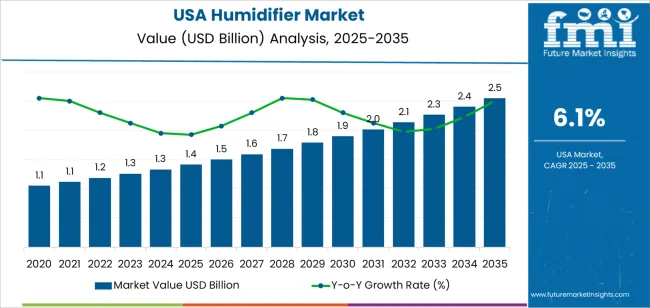
Demand for humidifiers in USA is projected to grow from USD 1.4 billion in 2025 to USD 2.5 billion by 2035, reflecting a compound annual growth rate (CAGR) of 6.1%. From USD 1.1 billion in 2020, demand increases steadily each year, reaching USD 1.4 billion in 2025. Between 2025 and 2030, the demand will grow from USD 1.4 billion to USD 1.9 billion, with incremental increases in the adoption of both personal and commercial humidifiers. By 2035, the demand will rise further to USD 2.5 billion, supported by greater awareness of indoor air quality and a continued shift toward smart home systems. Increased health-consciousness, particularly regarding respiratory health, and improvements in product technology will further support this growth trend.
As the market for humidifiers matures, a saturation point will likely emerge after widespread adoption of these products in households and commercial spaces. By the end of the forecast period in 2035, nearly all potential users who are likely to adopt humidifiers will have done so. Beyond this point, growth may slow, relying more on product upgrades or replacements. The future demand beyond 2035 could depend on premium models offering advanced features such as smart connectivity or integrated air quality systems. As the sector reaches its peak, the focus will shift from broad adoption to niche offerings, catering to specific needs in health, comfort, and energy efficiency within both residential and commercial environments.
| Metric | Value |
|---|---|
| Industry Value (2025) | USD 1.4 billion |
| Forecast Value (2035) | USD 2.5 billion |
| Forecast CAGR (2025 to 2035) | 6.1% |
The demand for humidifier in USA is largely driven by growing awareness of indoor air quality and health concerns. Dry air in homes and offices can lead to respiratory issues, aggravated allergies, and discomfort. Many individuals are now seeking solutions to improve air quality, particularly in urban environments where heating and cooling systems often reduce humidity. This has led to an increase in the use of humidifiers to create a more comfortable and healthier indoor atmosphere. Furthermore, as respiratory illnesses become more prevalent, consumers are turning to humidifiers as part of their wellness routines.
In addition to health benefits, technological advancements in humidifier designs are contributing to market growth. Modern models are equipped with smart features like sensors, connectivity, and energy-efficient operation, making them appealing to tech-savvy consumers. The rising trend in residential construction, home renovations, and healthcare infrastructure investments also fuels demand. Despite these growth factors, challenges such as the need for regular maintenance and competition from other air-quality products may limit wider adoption. Nevertheless, the overall demand for humidifiers continues to increase as consumers prioritize health, comfort, and air quality.
The demand for humidifiers in the USA is influenced by both the type of humidifier and its installation type. Humidifier types include ultrasonic, cool mist, warm mist, and others, each serving different consumer needs. The installation types are categorized into portable and fixed systems, which determine the mobility and convenience of the humidifiers. These segments highlight the preferences of consumers based on their specific requirements for humidity control, such as room size, desired humidity levels, and whether they need a portable or permanent solution.
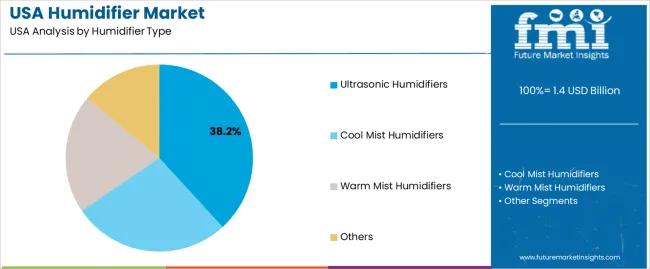
Ultrasonic humidifiers represent 38% of the total demand for humidifiers in the USA. These devices are popular due to their quiet operation and energy efficiency. Ultrasonic technology uses high-frequency sound vibrations to create a fine mist, making them ideal for bedroom use or in environments where noise reduction is important. The increasing focus on health and comfort has also driven the adoption of ultrasonic humidifiers, as they help maintain optimal indoor air quality by adding moisture to dry air without the need for heating elements.
The demand for ultrasonic humidifiers is further supported by the growing awareness of the health benefits of proper humidity levels, such as reducing dry skin, nasal congestion, and respiratory issues. These devices are particularly popular in regions with cold winters, where indoor air can become dry and uncomfortable. As consumers prioritize comfort and energy efficiency, ultrasonic humidifiers continue to lead the market due to their silent operation, ease of use, and effectiveness in maintaining ideal humidity levels.

Portable humidifiers account for 64.5% of the total demand for humidifiers in the USA, making them the most popular installation type. The demand for portable humidifiers is driven by their versatility, ease of use, and convenience. These devices can be moved between rooms or taken on the go, making them suitable for a wide range of applications, from home use to travel. Portable humidifiers are particularly favored in smaller spaces or in homes where users prefer to adjust the humidity in specific rooms rather than throughout the entire house.
The popularity of portable humidifiers is also fueled by their affordability and ease of maintenance. Consumers can choose the size and capacity of a portable humidifier based on their needs, making them a practical and customizable solution for improving indoor air quality. Additionally, portable humidifiers are ideal for individuals who need quick relief from dry air, such as those with allergies or respiratory issues. As the demand for flexible, cost-effective, and health-conscious products grows, portable humidifiers continue to dominate the market.
The demand for humidifiers in the USA reflects rising concern for indoor air quality, growing prevalence of respiratory conditions, and increasing interest in smart home wellness devices. As climate control systems and energy efficient buildings become more common, many households and commercial spaces turn to humidifiers to maintain optimal humidity levels. At the same time, factors such as product cost, maintenance requirements, and concerns over misuse pose challenges. Understanding how these influences shape demand is essential for stakeholders in the humidifier sector in USA.
The integration of WiFi connectivity, voice control and app based monitoring in humidifiers has become a significant growth avenue in the USA. Consumers increasingly favour devices that allow remote adjustment of humidity, scheduling of mist output, and integration with broader smart home ecosystems. These features enhance convenience and align with broader wellness and lifestyle trends. As awareness of indoor air quality rises, smart humidifiers offer additional perceived value, thereby influencing purchase decisions and raising the overall demand for advanced humidifying devices.
Growing recognition of the health impacts of dry indoor air is pushing demand for humidifiers in the USA. Dry air can irritate skin, respiratory passages and mucous membranes; many homes and commercial buildings aiming to ensure occupant comfort and health adopt humidifiers as part of their indoor air solutions. This push is strengthened by higher rates of allergies and respiratory disorders, especially among aging populations. Consequently, humidifiers are seen increasingly not just as comfort devices but as essentials for maintaining indoor wellness.
Several barriers impede the widespread adoption of humidifiers in the USA. High end devices with advanced features tend to carry premium prices, which may deter cost sensitive consumers. Maintenance demands-such as regular cleaning to prevent mold or bacteria growth, filter replacements and proper operation-add to total cost‐of‐ownership. Some users may also question long‐term benefits or misuse the devices (over humidity leading to dampness or mold). These factors combine to slow uptake among certain segments despite growing awareness and demand.
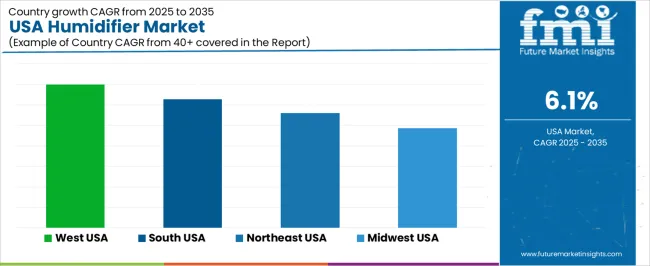
| Region | CAGR (%) |
|---|---|
| West | 7.0% |
| South | 6.3% |
| Northeast | 5.6% |
| Midwest | 4.9% |
The demand for humidifiers in the USA is growing steadily across all regions. The West leads with a 7.0% CAGR, driven by the region’s dry climate, high consumer awareness of air quality, and the adoption of humidifiers for health and comfort. The South follows with a 6.3% growth, influenced by warmer climates and the increasing need to manage indoor air quality in residential and commercial spaces. The Northeast shows a 5.6% growth, supported by seasonal temperature variations and a growing interest in air quality products. The Midwest, with a 4.9% CAGR, benefits from rising consumer focus on indoor air quality and the health benefits of using humidifiers.
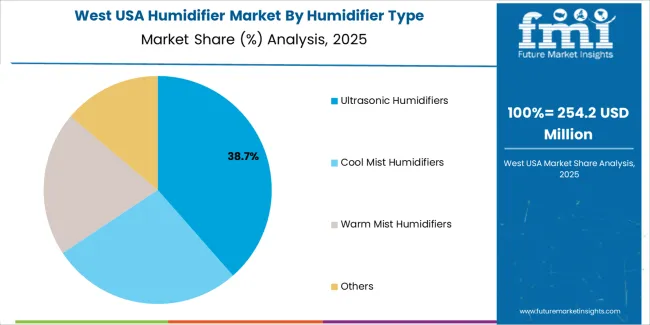
The West region of the USA is projected to grow at a CAGR of 7% through 2035 in demand for humidifiers. The region’s diverse climate, ranging from dry desert areas to cooler coastal regions, drives the demand for humidifiers to improve indoor air quality. States like California and Nevada, known for their dry weather, have a particularly high need for humidification systems to prevent dry skin, respiratory issues, and static electricity. The growing awareness of the health benefits of maintaining optimal humidity levels in homes and offices further contributes to this demand.

The South region of the USA is projected to grow at a CAGR of 6.3% through 2035 in demand for humidifiers. While the region generally experiences higher humidity levels, there is still a growing need for humidifiers in certain areas to balance indoor air quality. In states like Texas and Florida, where air conditioning is heavily used, indoor air can become too dry, especially in the winter months. The increasing awareness of the importance of maintaining proper humidity levels to prevent health issues such as dry skin, asthma, and allergies is also boosting demand.
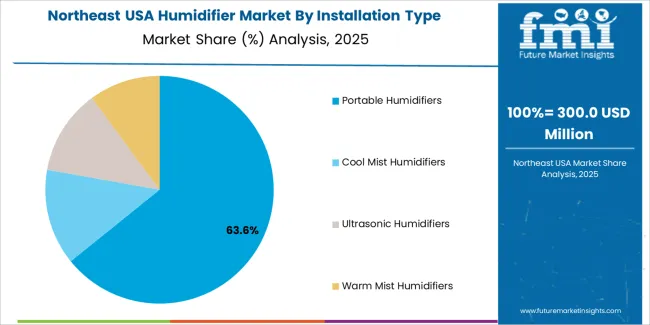
The Northeast region of the USA is projected to grow at a CAGR of 5.6% through 2035 in demand for humidifiers. The colder winters and seasonal variations in temperature contribute to a greater need for humidification, as indoor air becomes dry from heating systems. States like New York, Massachusetts, and Pennsylvania see consistent demand for humidifiers to improve indoor comfort and prevent dryness in the skin and respiratory system. The increasing focus on air quality, particularly in urban areas, further supports the adoption of humidifiers in homes, offices, and commercial spaces.
The Midwest region of the USA is projected to grow at a CAGR of 4.9% through 2035 in demand for humidifiers. The region experiences harsh winters and fluctuating indoor air quality, which creates a consistent need for humidification. States like Illinois, Michigan, and Ohio experience extended periods of cold weather, leading to dry indoor air from heating systems. As consumers increasingly seek ways to improve indoor air quality and mitigate health issues like dry skin, allergies, and respiratory problems, the demand for humidifiers is steadily growing in homes and workplaces.
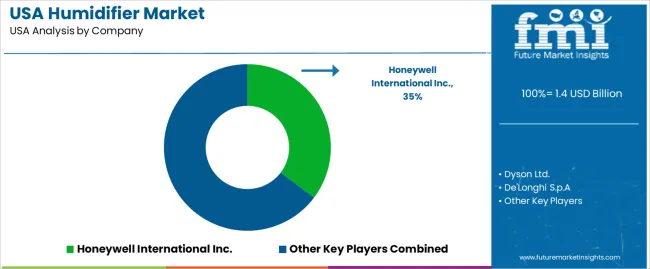
The demand for humidifiers in the USA is driven by growing awareness of indoor air quality and its effects on health. Dry indoor environments, caused by factors like heating systems or air conditioning, lead to discomfort such as dry skin, irritated airways, and aggravated respiratory conditions like asthma. Additionally, the rising trend in health-conscious living and consumer preference for products that improve air quality is boosting the demand for humidifiers. Modern units offer enhanced features such as quieter operation, smart connectivity, and built-in antimicrobial technology, appealing to a wide range of consumers.
Key players in the humidifier sector in the USA include Honeywell International Inc., Dyson Ltd., De'Longhi S.p.A, Condair, and BONECO AG. Honeywell offers a wide array of residential humidifiers, while Dyson is known for its premium, technology-driven models. De'Longhi provides versatile humidifiers alongside other home appliances. Condair and BONECO AG focus on specialized humidification systems for both residential and commercial use. These companies lead the market by continually innovating to meet consumer needs for more efficient and user-friendly humidification solutions.
| Items | Values |
|---|---|
| Quantitative Units (2025) | USD billion |
| Humidifier Type | Ultrasonic Humidifiers, Cool Mist Humidifiers, Warm Mist Humidifiers, Others |
| Installation Type | Portable Humidifiers, Fixed Humidifiers |
| End User | Residential Humidifiers, Commercial Humidifiers, Industrial Humidifiers |
| Sales Channel | Fixed Humidifiers, Portable Humidifiers |
| Regions Covered | Northeast, West, Midwest, South |
| Countries Covered | USA |
| Key Companies Profiled | Honeywell International Inc., Dyson Ltd., De'Longhi S.p.A, Condair, BONECO AG |
| Additional Attributes | Dollar by sales across humidifier types, installation types, and end-users; technological advancements in smart and energy-efficient humidifiers; seasonal demand fluctuations; health impact awareness and market adoption trends. |
The global demand for humidifier in USA is estimated to be valued at USD 1.4 billion in 2025.
The market size for the demand for humidifier in USA is projected to reach USD 2.5 billion by 2035.
The demand for humidifier in USA is expected to grow at a 6.1% CAGR between 2025 and 2035.
The key product types in demand for humidifier in USA are ultrasonic humidifiers, cool mist humidifiers, warm mist humidifiers and others.
In terms of installation type, portable humidifiers segment to command 64.5% share in the demand for humidifier in USA in 2025.






Our Research Products

The "Full Research Suite" delivers actionable market intel, deep dives on markets or technologies, so clients act faster, cut risk, and unlock growth.

The Leaderboard benchmarks and ranks top vendors, classifying them as Established Leaders, Leading Challengers, or Disruptors & Challengers.

Locates where complements amplify value and substitutes erode it, forecasting net impact by horizon

We deliver granular, decision-grade intel: market sizing, 5-year forecasts, pricing, adoption, usage, revenue, and operational KPIs—plus competitor tracking, regulation, and value chains—across 60 countries broadly.

Spot the shifts before they hit your P&L. We track inflection points, adoption curves, pricing moves, and ecosystem plays to show where demand is heading, why it is changing, and what to do next across high-growth markets and disruptive tech

Real-time reads of user behavior. We track shifting priorities, perceptions of today’s and next-gen services, and provider experience, then pace how fast tech moves from trial to adoption, blending buyer, consumer, and channel inputs with social signals (#WhySwitch, #UX).

Partner with our analyst team to build a custom report designed around your business priorities. From analysing market trends to assessing competitors or crafting bespoke datasets, we tailor insights to your needs.
Supplier Intelligence
Discovery & Profiling
Capacity & Footprint
Performance & Risk
Compliance & Governance
Commercial Readiness
Who Supplies Whom
Scorecards & Shortlists
Playbooks & Docs
Category Intelligence
Definition & Scope
Demand & Use Cases
Cost Drivers
Market Structure
Supply Chain Map
Trade & Policy
Operating Norms
Deliverables
Buyer Intelligence
Account Basics
Spend & Scope
Procurement Model
Vendor Requirements
Terms & Policies
Entry Strategy
Pain Points & Triggers
Outputs
Pricing Analysis
Benchmarks
Trends
Should-Cost
Indexation
Landed Cost
Commercial Terms
Deliverables
Brand Analysis
Positioning & Value Prop
Share & Presence
Customer Evidence
Go-to-Market
Digital & Reputation
Compliance & Trust
KPIs & Gaps
Outputs
Full Research Suite comprises of:
Market outlook & trends analysis
Interviews & case studies
Strategic recommendations
Vendor profiles & capabilities analysis
5-year forecasts
8 regions and 60+ country-level data splits
Market segment data splits
12 months of continuous data updates
DELIVERED AS:
PDF EXCEL ONLINE
USA Medical Coding Market Size and Share Forecast Outlook 2025 to 2035
USA Labels Market Size and Share Forecast Outlook 2025 to 2035
USA Plant-based Creamers Market Size and Share Forecast Outlook 2025 to 2035
USA Barrier Coated Paper Market Size and Share Forecast Outlook 2025 to 2035
USA Electronic Health Records (EHR) Market Size and Share Forecast Outlook 2025 to 2035
USA Animal Model Market Size and Share Forecast Outlook 2025 to 2035
USA and Canada Packer Bottle Market Size and Share Forecast Outlook 2025 to 2035
USA Stretch Hood Films Market Size and Share Forecast Outlook 2025 to 2035
USA and Canada Fence Screen Market Size and Share Forecast Outlook 2025 to 2035
USA Lubricant Contaminated HDPE Container Waste Market Size and Share Forecast Outlook 2025 to 2035
USA Commercial Walk-In Refrigeration Market Size and Share Forecast Outlook 2025 to 2035
USA & Canada Pre-painted Steel Roofing and Cladding Market Size and Share Forecast Outlook 2025 to 2035
USA Residential Cotton Candy Maker Market Size and Share Forecast Outlook 2025 to 2035
USA Faith Based Tourism Market Size and Share Forecast Outlook 2025 to 2035
United States NFC Lemon Juice Market Analysis - Size, Growth and Forecast 2025 to 2035
USA and Canada Copper Market Insights - Demand, Size & Industry Trends 2025 to 2035
USA Ground and Precipitated Calcium Carbonate Market Growth by Product Type, Application, End-Use, and Region in 2025 to 2035
Humidifier Market Insights - Size, Trends & Forecast 2025 to 2035
United States Animal Feed Additives Market Report – Trends, Growth & Forecast 2025–2035
United States Wild Rice Market Outlook – Size, Demand & Forecast 2025–2035

Thank you!
You will receive an email from our Business Development Manager. Please be sure to check your SPAM/JUNK folder too.
Chat With
MaRIA